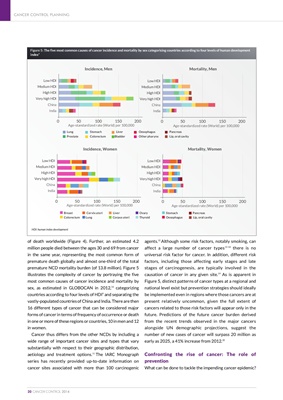
CANCER CONTROL PLANNING
CANCER CONTROL 2014 21
Many of the NCD risk factors mentioned in Figure 1 are
highly relevant to the prevention of cancer of the lung
(smoking), and fairly relevant to the one or other of cancers of
the breast and colon (overweight and lack of physical activity,
and alcohol). These three cancer sites have lower incidence
and mortality in the lowest-income countries but they are
increasing because of less favourable trends in smoking than
in high-income countries;21 and rapid changes in lifestyle e.g.,
increase in obesity and sedentary life, and reproductive
habits, i.e., decrease and postponement of childbearing that
are associated with breast cancer increases. Some caution is
needed in interpreting these global estimates given the
variable quality and coverage of sources of cancer
registration (see http://globocan.iarc.fr), vital registration,22
and assumptions in predicting the future cancer burden.23
However, some preventive tools target individual cancer
sites, but not necessarily other NCDs, can be extremely
effective and potentially cost-effective. For instance, among
the four cancer sites that show much more elevated
incidence and mortality in low- than high-income countries
(cervix, liver, stomach and oesophagus),24 all except cancer of
the oesophagus are predominantly caused by chronic
infections, although tobacco and/or alcohol consumption also
play a role.
Conservative estimates showed that about two million
cancer cases per year (16% of the global cancer burden) are
attributable to a few chronic infections.25 Huge variations are
seen by continent and country. The fraction of cancer
attributable to infections is largest in sub-Saharan Africa
(32.7%) and China (26.1%) and smallest in Australia and New
Zealand and in North America (≤4%) (Table 1). In addition, at
a country-level, the fraction of cancer attributable to
infections also tends to be larger in the poor than in the rich
making the prevention or eradication of these infections a
powerful tool to overcome health inequalities in cancer
incidence within and between countries. It is therefore highly
appropriate that vaccination against two of the principal
cancer-causing infectious agents, i.e., human papillomavirus
(HPV) (100% of cancer of the cervix, the majority of cancers
of the ano-genital tract, and some in the oro-pharynx); and
hepatitis B virus (HBV) (the most important cause of
hepatocellular carcinoma worldwide) are included in the
Global Monitoring Framework (Figure 2); these are however
not among the priority targets (Figure 1).
Confronting the rise of cancer: The role of early
detection and screening
Another feature of the majority of cancers is that they have a
long latent phase and are preceded by pre-neoplastic lesions.
Early detection and treatment of cancer or precancerous
lesions allowed substantial declines in cancer mortality in
high-income countries and would greatly improve survival in
less developed countries in which access to expensive cancer
treatment is limited.
26 Firm evidence of the efficacy of
Table 1: Number of new cancer casesa in 2008 attributable to infectious agents, by geographic region25
Number of new cases in 2008 Number attributable to infection PAF (%)
Africa
Sub-Saharan Africa 550,000 180,000 32.7%
North Africa and west Asia 390,000 49,000 12.7%
Asia
India 950,000 200,000 20.8%
Other central Asia 470,000 81,000 17.0%
China 2,800,000 740,000 26.1%
Japan 620,000 120,000 19.2%
Other east Asia 1,000,000 230,000 22.5%
America
South Americab
910,000 150,000 17.0%
North America 1,600,000 63,000 4.0%
Europe 3,200,000 220,000 7.0%
Oceania
Australia and New Zealand 130,000 4,200 3.3%
Other Oceania 8,800 1,600 18.2%
More developed regions
c
5,600,000 410,000 7.4%
Less developed regions
d
7,100,000 1,600,000 22.9%
World 12,700,000 2,000,000 16.1%
PAF=population attributable fraction.
a
Numbers are rounded to two significant digits. b
Includes Mexico.
c
Total for Japan, North America, Europe, and Australia and New Zealand. d
Total for all other regions.